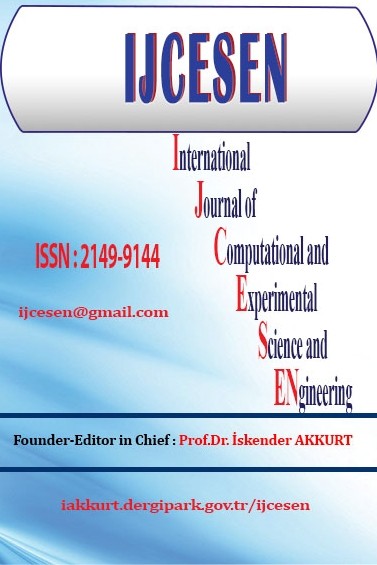Wind Turbine Blade Design with Computational Fluid Dynamics Analysis
Wind Turbine Blade Design with Computational Fluid Dynamics Analysis
Blade design Wind turbine,
___
- [1] K.Y. Maalawi, M.T.S. Badawy, “A direct method for evaluating performance of horizontal axis wind turbines”, Renew. Sustain. Energy Rev. 5 (2001) 175–190. doi:10.1016/S1364-0321(00)00017-4.
- [2] A. Erişen, M. Bakirci, NACA 0012 VE NACA 4412 Kanat Kesitlerinin Yeniden Tasarlanarak Had ile Analiz Edilmesi, J. Eng. Technol. Sci. 50–82.
- [3] M. Jureczko, M. Pawlak, A. Mężyk, “Optimisation of wind turbine blades”, J. Mater. Process. Technol. 167 (2005)463–471. doi:10.1016/j.jmatprotec.2005.06.055.
- [4] W. Xudong, W.Z. Shen, W.J. Zhu, J.N. Sørensen, C. Jin, “Shape optimization of wind turbine blades”, Wind Energy. 12 (2009) 781–803. doi:10.1002/we.335.
- [5] A. Varol, C. İlkılıç, Y. Varol, “Increasing the efficiency of wind turbines”, J. Wind Eng. Ind. Aerodyn. 89 (2001) 809–815. doi:10.1016/S0167-6105(01)00069-1.
- [6] M.M. Duquette, K.D. Visser, “Numerical Implications of Solidity and Blade Number on Rotor Performance of Horizontal-Axis Wind Turbines”, J. Sol. Energy Eng. 125 (2003) 425. doi:10.1115/1.1629751.
- [7] E. Benini, A. Toffolo, “Optimal Design of Horizontal-Axis Wind Turbines Using Blade-Element Theory and Evolutionary Computation”, J. Sol. Energy Eng. 124 (2002) 357. doi:10.1115/1.1510868.
- [8] X. Liu, Y. Chen, Z. Ye, “Optimization model for rotor blades of horizontal axis wind turbines”, Front. Mech. Eng. China. 2 (2007) 483–488. doi:10.1007/s11465-007-0084-9.
- [9] K. Kishinami, H. Taniguchi, J. Suzuki, H. Ibano, T. Kazunou, M. Turuhami, “Theoretical and experimental study on the aerodynamic characteristics of a horizontal axis wind turbine”, in: Energy, 2005: pp. 2089–2100. doi:10.1016/j.energy.2004.08.015.
- [10] M. Guleren, S. Demir, “Rüzgar türbinleri için düşük hücum açılarında farklı kanat profillerinin performans analizi”, Isı Bilim. ve Tek. Derg. 31 (2011) 51–59.
- [11] P. Devinant, T. Laverne, J. Hureau, “Experimental study of wind-turbine airfoil aerodynamics in high turbulence”, J. Wind Eng. Ind. Aerodyn. 90 (2002) 689–707. doi:10.1016/S0167-6105(02)00162-9.
- [12] L. Bermudez, A. Velázquez, A. Matesanz, “Numerical simulation of unsteady aerodynamics effects in horizontal-axis wind turbines”, Sol. Energy. 68 (2000) 9–21. doi:10.1016/S0038-092X(99)00056-0.
- [13] I. Ansys, ANSYS FLUENT theory guide, Knowl. Creat. Diffus. Util. 15317 (2009) 724–746. doi:10.1016/0140-3664(87)90311-2.
- [14] J.F. Manwell, J.G. McGowan, A.L. Rogers, “Wind energy explained: theory, design and application”, 2009. doi:10.1002/9781119994367.
- [15] T.C. Yenilenebilir Enerji Genel Müdürlüğü, http://www.eie.gov.tr/.
- Yayın Aralığı: 4
- Başlangıç: 2015
- Yayıncı: Prof.Dr. İskender Akkurt
Generation of Pseudo Velocity Logs from Resistivity Logs and an Applied Example from Thrace
Continuous and Discontinuous Contact Problems of a Functionally Graded Layer
Evaluation of Rock Fall Risk in Kilis (Turkey) City by Using GIS and Remote Sensing
Mehmet Ali ÇELİK, Ali Ekber GÜLERSOY
Serpil ERYILMAZ, Nesuhi AKDEMİR, Ersin İNKAYA
A Computational Comparison of Flow and Pressure Fields in Axial and Reverse Flow Cyclone Separators
